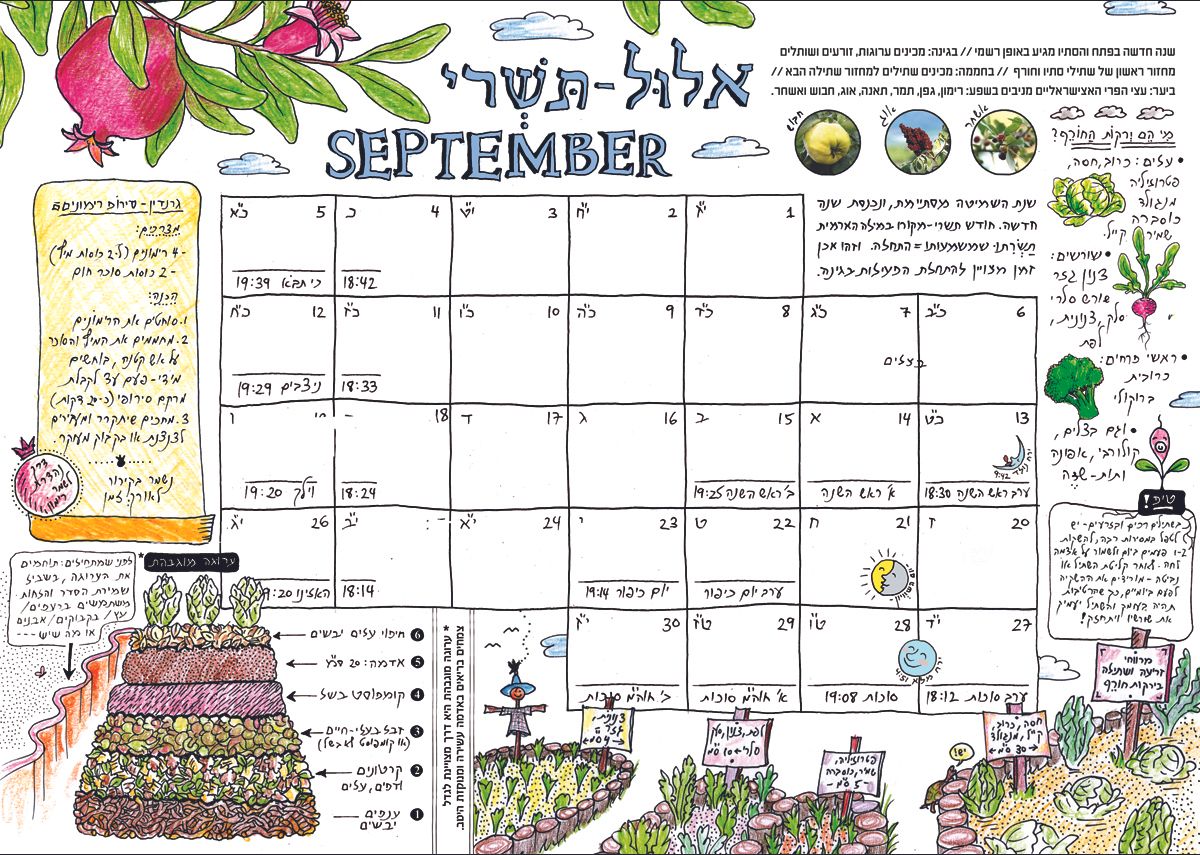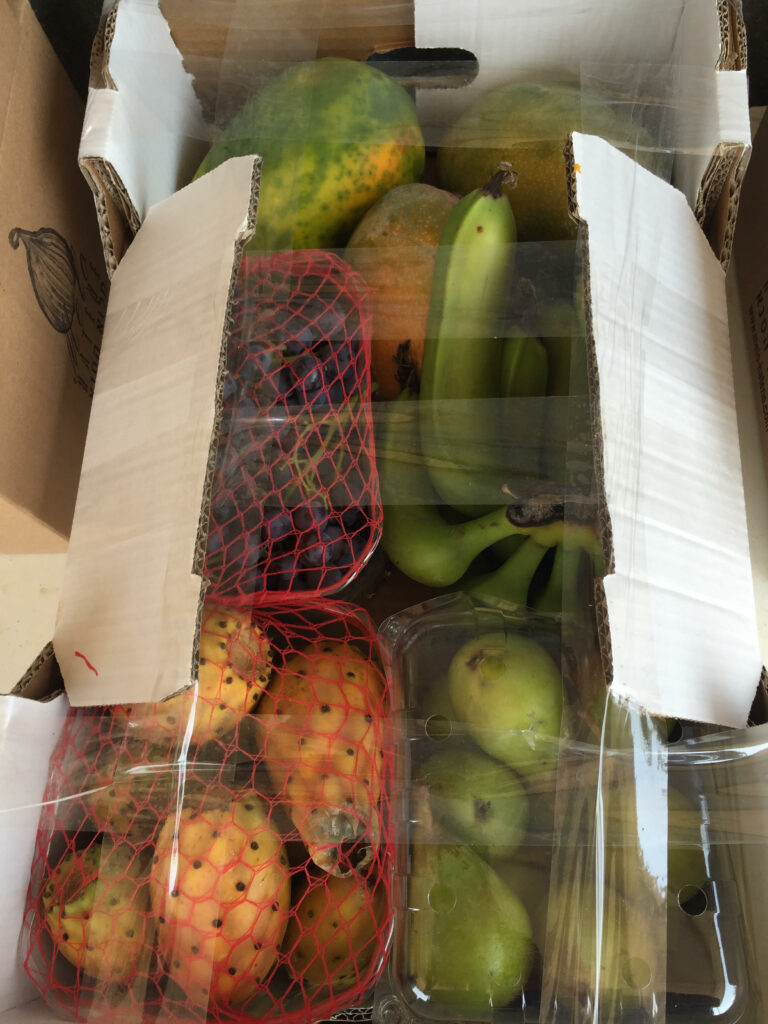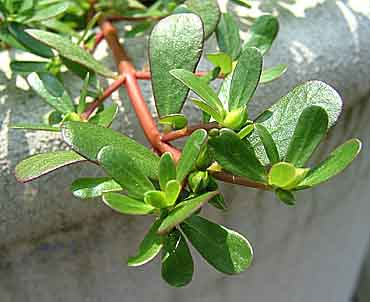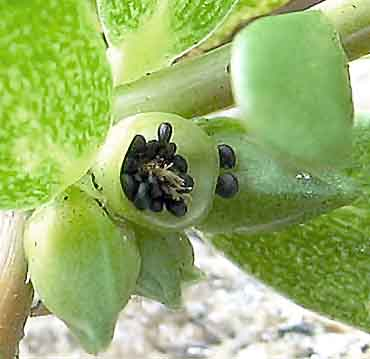 Reminding you that we are taking orders for Ilana and Davidi’s beautiful calendar!
Reminding you that we are taking orders for Ilana and Davidi’s beautiful calendar!
The “Home Garden Calendar” accompanies you through each day in your home garden and the surrounding nature. Its sage words and captivating illustrations (from Ilana’s talented pen) are full of knowledge, advice, instructions and excellent tips for any gardener, home farmer, cook and eater, or anyone who wants to connect to the varying pace of life, seasons and climate in our tiny country. Take a look at their website for a peek at their calendar.
Thanks to our strong friendship, Ilana and Davidi are offering their calendar to Chubeza clients for 70 NIS each. Orders may be placed by emailing ([email protected]) or texting (0546535980) us. The calendars will arrive during the first two weeks of September. Quantity is limited, so hurry up and order!
_________________________
Many of you have been asking about the fruit boxes, especially the large-size “Family Fruit Box,” so here’s a chance to take a look for yourself… This is a sample Family Fruit Box :

It contains 4-5 types of summer fruit in greater quantities than the other size boxes. The Family Box costs 140 NIS. A small fruit box goes for 55 NIS, and a large one is 85 NIS.
Wishing you sweet days…
_____________________________
The Power of Purslane
The summer is not easy on the greens. They are in great need of a breather from the heat, withering away as the Mid-Eastern sun burns them, dries them up and basically destroys them. As we mentioned last week, we are doing our best to ease their strife by spreading a shade net over them and providing extra water, but still – they are quite stressed by the summer. This is the reason lettuce has been MIA from your boxes over the past few weeks, as well as Swiss chard, which actually did pretty well over the first part of summer. Even the New Zealand spinach is having a tough time these days.
 Interestingly, the wild weeds, like surviving street cats, know how to stay alive. One wild thing that thrives at survival is the purslane (Raglat HaGina in Hebrew, Rijla in Arabic, verdolaga in Spanish), which does not appear to be an uninvited visitor, but resembles an esteemed guest that is being pampered and begged to remain. That’s how it always is with this little invader. But in the spirit of acceptance and seeing things in a clearer light, we have decided to outsmart her and place her in your boxes. This way we all win, and you receive a nice quantity of an excellent vegetable, yummy and juicy and very healthy.
Interestingly, the wild weeds, like surviving street cats, know how to stay alive. One wild thing that thrives at survival is the purslane (Raglat HaGina in Hebrew, Rijla in Arabic, verdolaga in Spanish), which does not appear to be an uninvited visitor, but resembles an esteemed guest that is being pampered and begged to remain. That’s how it always is with this little invader. But in the spirit of acceptance and seeing things in a clearer light, we have decided to outsmart her and place her in your boxes. This way we all win, and you receive a nice quantity of an excellent vegetable, yummy and juicy and very healthy.
It grows in home gardens and irrigated fields, in emptied-out fish pools, along the roadsides where the earth is damp, or in sidewalk cracks. And though it grows wild here, it is still considered an “immigrant plant.” The purslane’s story is actually super interesting, as she arrived in Europe and the Middle East many years prior to Columbus discovering America, and must have done it herself, naturally. In an article by Avinoam Danin “Swimming from Mexico to Israel” (Hebrew) he tells the following story:
The purslane grew in Central America in very special conditions. I found it on a tour I conducted in Nicaragua, a tropical country with high temperatures (29 degrees Celsius on average) where the differences between summer and winter/day and night are very minimal…. The plant requires high temperatures and light in order to sprout…. The conditions for sprouting exist in Israel in places where men have removed the competitors seeking shady sprouting sites….We don’t really know how the purslane made its way to Israel, but we have several conjectures. We examined the sprouting ability of its seeds after floating in sea water. After they floated in the ocean for six months, a high percentage of the seeds sprouted one day after being transferred to sweet water…. Purslane seeds were found in an archeological site from the Roman era in Germany, and it is likely they made the journey from America to Europe naturally. Its spreading was encouraged by an increase of disturbed habitats.”
 Well, the purslane completed that long swim a good while ago. Its Hebrew name even appears in the Mishna. Our wise sages used to eat it raw or cooked: “Purslane may be eaten until wild purslane is finished from the valley of Beit Netofa,” instructs Mishna Sheviit (9:5). The plant’s Hebrew and Arabic name derives from the word for feet, probably because it “crawls” on earth on leaves and stems that resemble feet. And as a farmer, I can testify to the fact that it has very busy feet, as it rushes to any source of water and takes over the territory quick as a flash.
Well, the purslane completed that long swim a good while ago. Its Hebrew name even appears in the Mishna. Our wise sages used to eat it raw or cooked: “Purslane may be eaten until wild purslane is finished from the valley of Beit Netofa,” instructs Mishna Sheviit (9:5). The plant’s Hebrew and Arabic name derives from the word for feet, probably because it “crawls” on earth on leaves and stems that resemble feet. And as a farmer, I can testify to the fact that it has very busy feet, as it rushes to any source of water and takes over the territory quick as a flash.
Farmers and gardeners do everything they can to weed it out before purslane reaches the seed stage. However, this mission is fraught with difficulty and requires high alert, as within three weeks from sprouting the little weed is brimming with fertile seeds just bursting to scatter all over the place. Even if you pull it out and place it on the bed, the purslane’s seeds will continue to ripen. Thus, if you are attempting to battle it, take the purslane far away from the garden to stage the war. Best if you send her straight to your salad bowl.
And if we’re already in the kitchen, it is true that here purslane is known as chicken feed, specifically since in the beginning of the last century when people raised their own poultry, the purslane saved them in the summer months when green weeds and grass are scarce. But for many years now this wonder weed has been used for human food all over Europe, and here in the Holy Land as well. Nissim Krispil writes in his plant anthology that he heard from Jacom Lishinsky about the shepherds of the Ayun Valley, not far from Metulla, who used to make purslane pancakes when they finished milking the herds. They would spread labane on pitta, place the pancakes on top of it, then roll them, seal, and serve. This delicatessen was termed Lafat al arusi, a roll for the bride, served to brides on their wedding day. They would also prepare labane with chopped purslane, chopped green spicy peppers, olives and chopped onion.
Sari Anski writes: “Purslane is great in a simple salad, with minced garlic (or onion), a touch of oil, salt and lots of lemon juice. In Greece it is served in the summer alongside Greek salad with feta cheese, tomatoes, black olives and onion. It’s also great in a Fattush-style vegetable salad (with dried pitta bits rubbed in garlic), Salade Niçoise, eggplant salad and tabbouleh. I recommend adding generous amounts of purslane to cream cheese or labane, with scallions and lots of olive oil to get a tzasiki-like salad. Purslane goes great with cucumbers or pickles and radishes. There are those who pickle the leaves in vinegar as well. It makes a great chilled tartar soup with cucumbers, garlic and a little bit of vinegar, quaffed with a few ice cubes. It can be added to meatballs. There are those who scatter salt on the chopped purslane greens to absorb the liquid, then squeeze out the liquid after half an hour. This way the leaves secrete gelatin and you get a texture similar to Maluchia. I have found that it is great to add these gelatinous leaves to chicken stock at the end of cooking and then squeeze while adding some lemon juice. In northern France, purslane has been cultivated and used not only in salads but also steamed in butter like spinach.”
Remember those chickens? Raising them on purslane turned out to be a bonus, as its high nutritional value contributed to the enrichment of the eggs. Today, they probably would place those eggs in specially decorated crates and sell them for a pretty price due to their high omega 3 value. Because this purslane, growing out of every sidewalk crack, ridiculed and considered low class, should actually receive a place of honor on the shelves of every health food store, taking its place alongside flax seeds and imported fish oil capsules. Purslane is bursting with omega 3-style fatty acids. One hundred grams of fresh purslane leaves contain 350 mg ALA, alpha linolenic acid, the kind that exists in flax seeds, sunflower seeds and walnuts. Omega 3 type fatty acids are helpful in balancing the omega 6 style fatty acids that exist in vegetable oils. Purslane contains omega 3 and omega 6 at a ratio of 6 to 22, an important characteristic that makes it an honorable member of the health-aspiring community. In addition, purslane is a good source of vitamins A, C, B-1, B-2, B-3, B-6 and folic acid. It also contains calcium, iron, magnesium, phosphorus, potassium and copper.
It’s the last week of summer vacation. Here’s hoping our little friend, purslane, will help you cool off with cool recipes.
Alon, Bat Ami, Dror, Yochai and the Chubeza team
___________________________
WHAT’S IN THIS WEEK’S SUMMER BOXES?
Monday: Eggplant, coriander/mint (nana)/ parsley, pumpkin slice, potatoes, tomatoes, corn/red+green bell peppers, onions/leeks, basil/purslane, cherry tomatoes, cucumber, Thai beans.
Large box, in addition: Scallions, butternut squash, okra.
Wednesday: Eggplant, coriander/mint (nana)/parsley, pumpkin slice, potatoes, tomatoes, corn, garlic chive/leeks/scallions, cherry tomatoes, cucumber, Thai beans/okra, popcorn!!!.
Large box, in addition: , butternut squash, red+green bell peppers, basil/New Zealand spinach
And there’s more! You can add to your basket a wide, delectable range of additional products from fine small producers: flour, fruits, honey, dates, almonds, garbanzo beans, crackers, probiotic foods, dried fruits and leathers, olive oil, bakery products and goat dairy too! You can learn more about each producer on the Chubeza website. On our order system there’s a detailed listing of the products and their cost, you can make an order online now!
